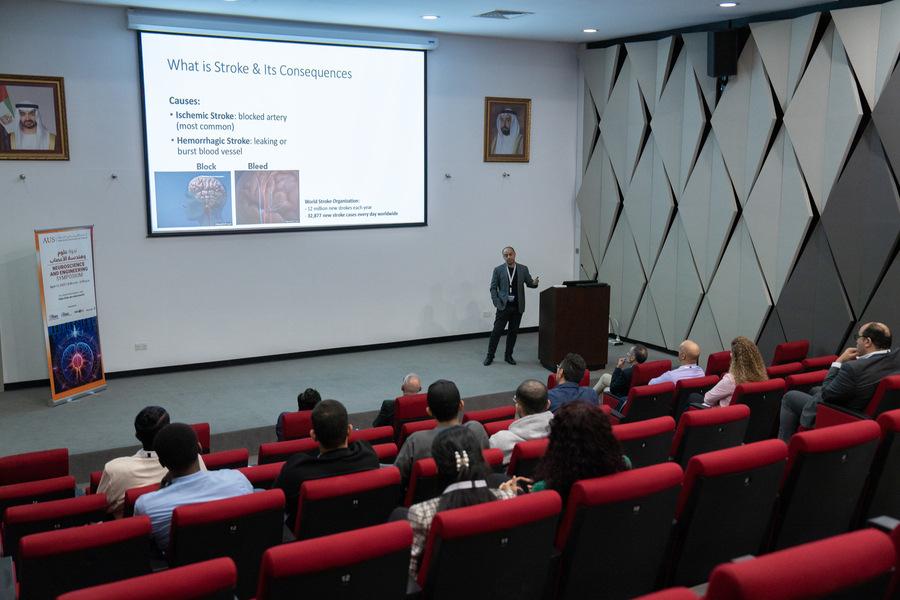- About
- Admissions
- Study at AUS
- Prospective Students
- Bachelor's Degrees
- Master's Degrees
- Doctoral Degrees
- Admission Publications
- International Students
- Contact Admissions
- Grants and Scholarships
- Sponsorship Liaison Services
- Testing Center
- New Student Guide
- File Completion
- New Student Orientation
- Payment Guide
- Executive Education
- Students with Disabilities
- Academics
- Life at AUS
- Research
- Contact Us
- Apply Now
- .

AUS welcomes experts at NeuroScience and Engineering Symposium to explore the fascinating world of neuroscience, engineering and AI-driven healthcare solutions
Reinforcing its role as a hub for advanced scientific research and interdisciplinary dialogue, American University of Sharjah (AUS) hosted the NeuroScience and Engineering Symposium (NSES’25) on April 13, 2025. The symposium gathered leading scholars, researchers and students to explore the latest developments in the field.
Topics covered included brain-computer interface, computational neuroscience, neural signal processing, generative AI, neuroprosthetics, neuroimaging, neuromorphic computing systems, cognitive neuroscience, rehabilitation technologies, neuroplasticity and more.
The keynote address was delivered by Dr. Mahmoud Hassan of MINDIG (France and Iceland), titled “A Century of Electroencephalography: From Brain Waves to Precision Psychiatry.” His address explored the historical evolution and future potential of electroencephalography (EEG)—a technique that records electrical activity in the brain using sensors placed on the scalp.
Invited speakers in the oral sessions represented a range of prominent institutions from within the UAE and abroad, including AUS, UAE University (UAEU), Khalifa University (KU), New York Abu Dhabi (NYUAD), Abu Dhabi University (ADU), and Mohammed Bin Rashid University of Medicine and Health Sciences (MBRU). Their presentations offered insights into cutting-edge research that bridges neuroscience and engineering, with real-world applications in diagnostics, rehabilitation, human-machine interaction and more.
In parallel, the symposium hosted two vibrant student poster sessions that showcased original research from AUS students and participants from UAEU, MBRU, NYUAD, KU and ADU. Young researchers were able to present their work to peers, faculty and industry experts, with the winning posters recognized during the event’s closing ceremony.
Dr. Hasan Al Nashash, Professor of Electrical Engineering at AUS, Coordinator of the PhD in Biosciences and Bioengineering and symposium chair, remarked: “NSES’25 demonstrated how impactful cross-disciplinary collaboration can be in decoding the brain’s complexity. From AI and rehabilitation technologies to imaging and cognition, this symposium reflected the scope and ambition of neuroscience and engineering research in the region.”
Dr. Fadi Aloul, Dean of the College of Engineering at AUS, added: “The research showcased at NSES’25 demonstrates how interdisciplinary inquiry is driving the future of science and technology. At AUS, we are proud to be nurturing this kind of innovation through a thriving research environment that connects ideas across fields to address today’s most pressing challenges.”
NSES’25 was organized by AUS faculty members Dr. Hasan Al Nashash, Dr. Nasir Khan, Dr. Amani Al-Othman, Dr. Reem Khalil, Dr. Usman Tariq, Dr. Mohammad Al-Sayah and Dr. Hasan Mir, and was sponsored by IEEE EMBS AUS Student Chapter, IEEE EMBS Neural and Rehabilitation Engineering, MINDIG and Petrofac.

